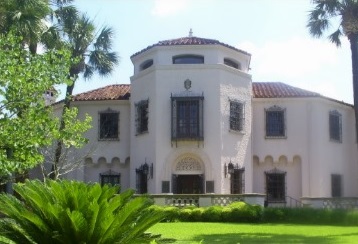
McNay Art Museum, San Antonio, Texas. Photo courtesy of the museum.
This edition of Riverwalk Jazz presents a special concert featuring The Jim Cullum Jazz Band performing music of the early 20th century composer of American popular song Jerome Kern, captured live at the McNay Art Museum in San Antonio.
The core of the McNay Art Museum is a 24-room Spanish Colonial Revival House, the home of benefactress Marion Koogler McNay from the late 1920s until her death in 1950 and the venue for this broadcast concert. The first museum of modern art in Texas, the McNay collection contains works by Paul Cezanne, Pablo Picasso, Henri Matisse, Georgia O’Keefe, Diego Rivera and Paul Gauguin.
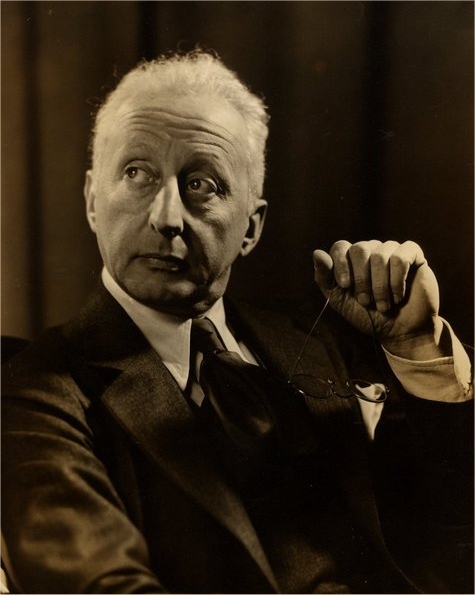
Jerome Kern. Photo by Alfredo Valente.
More than fifty years after his passing, the music of Jerome Kern remains a cornerstone of the Great American Songbook, having survived the fads and fashions of four generations—it continues to be performed on the Broadway stage and recorded by major artists. Known for creating the musical Show Boat, Jerome Kern composed his enduring classics for both stage and movie musicals; works such as “The Way You Look Tonight,” “Old Man River,” “Smoke Gets in Your Eyes” and more.
In 1920 the Broadway impresario Flo Ziegfeld had a hit with the musical comedy Sally. It was a typical rags-to-riches Cinderella story set in a lavish production, a star vehicle for the reigning beauty queen Marilyn Miller. Jerome Kern’s contribution to the score included “Look for the Silver Lining.” Later covered in a storied version by Judy Garland, Kern’s song has since become both a staple of classroom sing-a-longs and a choice selection of many jazz artists for the recording studio. A version by trumpeter Chet Baker has been widely played on the Turner Classic Movies cable TV channel.
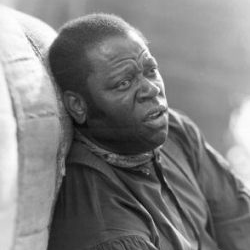
William Warfield as Joe, the dockhand in Show Boat. photo courtesy of the artist.
Jerome Kern was a brilliant creator, and in the early 20th century his compositions played a major role in elevating Broadway musical theater from mediocre entertainment to a distinctly American art form. Kern’s breakthrough work was his adaptation of Edna Ferber’s novel Show Boat, and the musical score he wrote in collaboration with the lyricist Oscar Hammerstein III. Since its 1927 debut at the Ziegfeld Theater, Show Boat has had seven New York revivals, three film adaptations, four London productions, one television broadcast and thousands of stagings around the world. In 1994 Show Boat returned to Broadway in an award-winning production by Harold Prince. The first film adaptation was made in 1929, and then in 1936 Universal released its highly acclaimed film version. In 1951, MGM once again produced Show Boat as a major motion picture, this time starring Ava Gardner, Kathryn Grayson, Joe E. Brown, and Riverwalk Jazz special guest William Warfield who appeared in the film as Joe the Dockhand, singing the celebrated theme “Old Man River” which is reprised throughout the film.
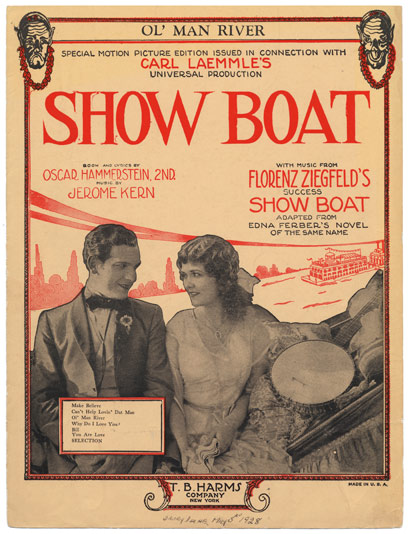
"Ol' Man River" sheet music. Image courtesy of van.ac.uk.
On this broadcast Mr. Warfield recalls his participation in the production of Show Boat: “I was touring Australia and we were looking at a newspaper column by Hedda Hopper. She wrote that MGM producer Arthur Freed had not found the person he wanted for Show Boat. My manager got a great idea. He was going back to the States anyhow, so he sent pictures of me to MGM’s Dore Schary. I went into a studio with an engineer and recorded “Old Man River,” and we sent the recording to Dore Schary, too. Meanwhile, on the radio, Peter Herman Adler, who was Mr. NBC Opera, was talking to somebody about this young man named William Warfield, and Oscar Levant, a good friend of Mr. Freed, heard it. Well, all three of these things came together, and I was cabled about two weeks later that I was signed even before I finished my tour in Australia.”
Warfield tells this story about recording “Old Man River” for the film: “They got all of the tracks set up; all of the mics set for the various instruments, and they said, ‘Let’s try one to see where we are.’ So, at the end of singing it through, there was dead silence, then somebody screamed, ‘It’s a take!’ They were so shocked, but I didn’t know it was so unusual. Apparently, you were supposed to record one song three, or four, or five, or six times and then piece it together. They were so impressed they called Louis Mayer from his office. He came down, and he had tears in his eyes. Later on I kidded him, I said, ‘Mr. Mayer, you weren’t so impressed by that, you were just thinking of all that money I saved you.’”
It’s said that when Jerome Kern approached Edna Ferber about adapting her novel for a musical, she thought it would never work because of the intensity of the racial issues raised in the book in stark contrast to the light, frothy atmosphere of musical theater then current. William Warfield says the work succeeded because “like a lot of art it mirrors things that are wrong and make us ashamed so that we change them. I think when she put that story together with all of those wonderful songs and all of that wonderful music of Jerome Kern, it packed a wallop that getting out picketing could never have done.”
This week Jim and the Band play “You Are Love,” one of their signature arrangements and part of their larger project comprising all the songs from Show Boat.
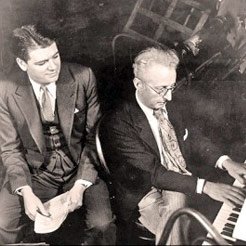
Hammerstein and Kern. Photo courtesy musicalsinlondon.co.uk.
Two years after the 1927 debut of Show Boat, Jerome Kern and Oscar Hammerstein were back at it working together on another major score, this time for a show called Sweet Adeline. Over the Fourth of July weekend 1929, newlyweds Oscar and Dorothy Hammerstein were guests on the Kerns’ yacht, aptly called Show Boat. Rehearsals for Sweet Adeline were beginning in mid-July. Hanging out in Florida, they had easy time writing songs. They spent long hours every day fishing and swimming but still managed to write thirteen new songs, including the ballad “Why Was I Born?” performed here by The Jim Cullum Jazz Band.
The great success of the Kern-Hammerstein musical collaboration was a reflection of their rich personal friendship. They enjoyed each other’s company, and they enjoyed solving each other’s creative problems. One day in 1925, they were writing songs for a new Ziegfeld comedy, Sonny. Kern was at the piano in his Bronxville home. Papers were strewn all over. He played his newest creation for Oscar. Immediately they could see they had a problem finding a lyric to fit the opening note. It had to be a single word that could be sung and held for nine beats. To make it more difficult, it had to be a word that could be repeated again and again without sounding totally ridiculous. Oscar found the perfect word they gave birth to the song “Who?” performed here by The Jim Cullum Jazz Band.
In the early 1900s when Jerome Kern first began publishing his songs, European operettas like Strauss’ Merry Widow were all the rage on Broadway. Nobody wanted anything to do with music made in America, so Kern had to go to London to make a name for himself as a composer in England before his work would be accepted by New York producers. Looking back over the past century of American songwriting, Kern emerges as one of four truly innovative American songwriters. Kern stands side by side with Irving Berlin, George Gershwin and Cole Porter. Early on, Kern was opposed to the way jazz instrumentalists, arrangers and singers interpreted his songs using jazz elements, but by the time he became involved in composing for motion pictures, jazz rhythm and tonality had firmly established itself in American popular culture, and Kern was more open to its influence in his songwriting.
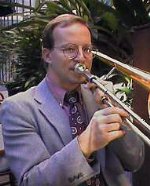
Trombonist Mike Pittsley. Photo courtesy of the artist.
An example is “I Won't Dance,” sung and danced by Fred Astaire for the 1935 film Roberta. The lyric is by Dorothy Fields. Beginning in the 1950s, jazz artists Anita O’Day and Ella Fitzgerald made memorable recordings of it. Our version recorded at The McNay Art Museum features trombonist Mike Pittsley.
In 1939 Kern and Hammerstein began collaborating on a new stage show, Very Warm for May. Not destined for commercial success, the show produced the classic love song “All the Things You Are.” The song’s soaring, sequential melody and challenging but logical chord changes made this song a cornerstone of the modern, or “Bebop” jazz movement, particularly after the iconic 1945 recording by Charlie Parker and Dizzy Gillespie.
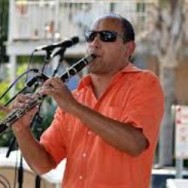
Clarinetist Evan Christopher. Photoby Kim Welsh, courtesy of the artist.
“I'm Old Fashioned,” the 1942 collaboration between Kern and lyricist Johnny Mercer, was written for the film You Were Never Lovelier starring Fred Astaire and Rita Hayworth. Notable jazz recordings include those by Ella Fitzgerald, John Coltrane and Chet Baker. The Jim Cullum Jazz Band performs the song in a classic jazz band style on this broadcast.
Beginning in 1934 Jerome Kern made his home in Hollywood where he wrote music for the movies. Kern collaborated with lyricist Ira Gershwin on one of his most famous songs “Long Ago and Far Away” for a 1944 film Cover Girl starring Gene Kelly, Rita Hayworth and Phil Silvers. Soon after the film’s release, the song was covered by major singing stars of the era, Dick Haymes, Helen Forrest, Bing Crosby, Jo Stafford and Perry Como. Later, jazz covers followed by George Shearing, Oscar Peterson, Chet Baker, Erroll Garner and Benny Carter. Joining the Jim Cullum Jazz Band on this tune is the New Orleans-based clarinetist Evan Christopher.
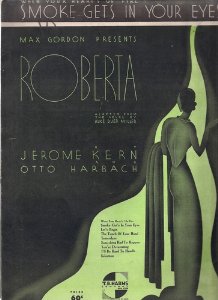
"Smoke Gets in Your Eyes" sheet music. Image courtesy thestrong.org.
“Smoke Gets in Your Eyes” remains Jerome Kern’s all-time greatest hit and probably his most popular song today. The story goes that this tune was first written as a brief piece to cover a scene change in Show Boat. It was a lively tap dance number to be performed in front of the curtain while the set was being changed. As it turned out, the piece was never used in Show Boat, so the tune sat on the shelf, waiting to be used in another show. In 1933, when Kern began work on the score for the stage show Roberta, his collaborator and lyricist Otto Harbach suggested that Kern’s leftover piece from Show Boat would make a nice ballad if played at a much slower tempo with longer notes and phrasing. Our version this week features a clarinet duo of Brian Ogilvie and Evan Christopher.
Photo credit for Home Page: Evan Christopher photo by Kim Welsh, courtesy of the artist.
Text based on Riverwalk Jazz script by Margaret Moos Pick ©1995

